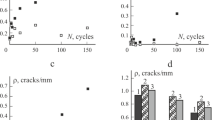Abstract
Experimental data are presented on the influence of cooling rate on the strength and deformation of thin Ag-4 pct Pd brazed joints in Fe-3 pct Si. It is observed that increasing the cooling rate (via water quenching vs furnace cooling) from the braze temperature can cause a drastic reduction in the strength of cylindrical butt brazed joints with a thickness to diameter ratio less than 0.02. The decrease in fracture strength is attributable to residual stresses and plastic strain caused by rapid cooling. The nature of the fracture process is unaffected by the cooling cycle and is always observed to be ductile failure caused by the growth and coalescence of microscopic shrinkage voids. Using hydrostatic annealing treatments, it is possible to restore the strength of rapidly cooled joints to values above those for furnace-cooled joints. This increase in strength is associated with a decrease in the volume fraction of microvoids accompanying the hydrostatic anneal.
Similar content being viewed by others
References
N. Bredzs:Welding J., 1954, vol. 33, p. 543-S.
W. G. Moffatt and J. Wulff:Welding J., 1963, vol. 42, p. 115-S.
H. J. Saxton: Ph.D. Thesis, Stanford University, August 1969.
A. J. West: Ph.D. Thesis: Stanford University, 1969.
J. R. Griffiths and J. A. Charles:Metal Sci. J., 1968, vol. 2, p. 89.
R. H. Leach and L. Edelson:J. Am. Soc. Naval Engrs., 1939, vol. 51, p. 56.
A. Nadai:Theory of Flow and Fracture of Solids, vol. 2, p. 394, McGraw-Hill, New York, 1963.
F. C. McClintock:Mechanical Behavior of Solids, p. 523, Addison-Wesley, Reading, Mass., 1966.
H. J. Saxton, A. J. West, and C. R. Barrett :Met. Trans., 1971, vol. 2, p.
E. Orowan, J. F. Nye, and W. J. Cairns: M.O.S. Armament Res. Dept. Rept., 1945, no. 16/45, p. 35. \
A.J.West, H.J. Saxton, and CR. Barrett:Met. Trans., 1971, vol. 2, p.
R. S. Teuting, J. J. Lynch, H. B. Westhart, and D. J. Richards:Residual Stress Measurements, ASM, Cleveland, 1950.
F. Garofalo:Fundamentals of Creep and Creep-Rupture in Metals, p. lll,Macmillan, New York, 1965.
A. J. West: unpublished data, Stanford University, Stanford, Calif., 1968.
F. C. McClintock:J. Appl. Mech., 1968, vol. 35, p. 363.
D. F. Thomason:J. Inst. Metals, 1968, vol. 96, p. 360.
B. I. Edelson and M. M. Baldwin, Jr.:Trans. ASM, 1962, vol. 55, p. 230.
Author information
Authors and Affiliations
Rights and permissions
About this article
Cite this article
Saxton, H.J., West, A.J. & Barrett, C.R. The effect of cooling rate on the strength of brazed joints. Metall Trans 2, 1019–1028 (1971). https://doi.org/10.1007/BF02664233
Received:
Issue Date:
DOI: https://doi.org/10.1007/BF02664233




